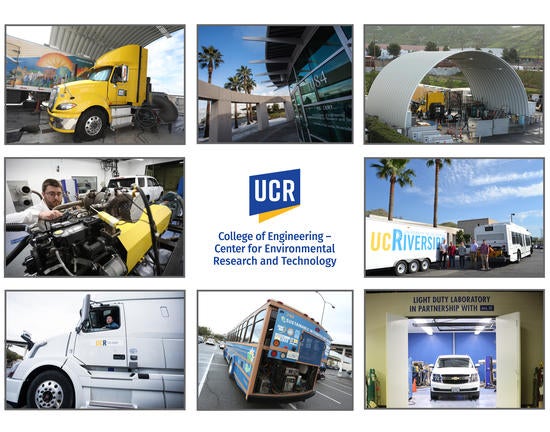The IEEE Intelligent Transportation System Society Institutional Lead Award is given annually for ITS researchers, practitioners, and research and development teams who have made significant contributions to research in ITS related fields, developed and deploy successful ITS system implementations, or demonstrated leadership in promoting ITS technologies. These awards are established to recognize, promote, and publicize major research contributions, application innovations with real-world impact, and ITS institutional leadership. This year CE-CERT was awarded this prestigious award for the Center's contribution to environmental technologies to improve transportation, air quality, and energy efficiency.
Most of today’s ITS applications and research projects are typically aimed at improving safety and mobility. At UC Riverside, the research has been more focused on the environmental and energy issues of ITS. CE-CERT helped pioneer this “eco-friendly” ITS (ECO-ITS) research area over two decades ago, when they first got involved in the National Automated Highway System Consortium (NAHSC, 1996) in estimating the environmental impacts of automated vehicle platooning. Since that time, CE-CERT researchers have developed more sophisticated transportation, energy, and emission models to better estimate the impacts of ITS and automation. In addition, CE-CERT’s ECO-ITS research program has been aimed at developing and evaluating innovative applications, based on the use of advanced technologies, targeted at reducing energy and environmental impacts of vehicles and transportation systems.
This ECO-ITS research program has gained attention from a variety of academic institutions (such as IEEE), industry, and from various government agencies. CE-CERT’s transportation research group was very active in the development of USDOT’s AERIS (Applications for the Environment: Real-Time Information Synthesis) program. This AERIS program examined how ITS technology in the form of “connected vehicles” (i.e., wireless communications between vehicles and infrastructure) can save energy and reduce vehicle emissions. CE-CERT’s ECO-ITS research program now consists of several emerging research areas. These areas consist of eco-routing navigation systems, dynamic eco-driving systems, eco-traffic signal systems, sustainable freight, and real-time energy management system.
Eco-Routing Navigation Systems aim to determine the minimum fuel consumption/emissions route between vehicle trip origins and destinations. CE-CERT’s research is one of the first published in this area (2007) and now has a U.S. patent on this topic. The Eco-Routing algorithms are currently being evaluated and utilized by automobile manufacturers, navigation companies, and trucking firms. In addition to eco-routing, CE-CERT is now developing low-exposure emissions routing algorithms that aim to reduce the impacts of harmful emissions in the community.
Dynamic Eco-Driving Systems provide real-time advice to drivers so that they can adjust their driving actions to save fuel and reduce emissions. This advice is provided in various forms including recommended speeds, optimal acceleration and deceleration, and driver alerts. The developed algorithms utilize real-time traffic and road grade data and 10-20% potential fuel savings have been demonstrated and documented. CE-CERT is now transitioning this technology to automated vehicles, achieving even greater fuel consumption and emissions reductions.
Eco-Traffic Signal Systems allow vehicles and traffic lights to communicate in order to minimize fuel/emissions as vehicles travel down a signalized corridor. CE-CERT’s research in this area focuses on designing vehicle velocity trajectories based on knowledge of a signal’s phase and timing, as well as developing new algorithms for traffic signal controllers to minimize total traffic energy/emissions.
Sustainable Freight Systems are aimed at reducing energy consumption and emissions in the heavy-duty truck sector. CE-CERT has applied the eco-routing navigation systems, dynamic eco-driving systems, and eco-traffic signal systems to heavy-duty trucks in both simulation and real-world environments, demonstrating fuel savings potential of 10 - 20%. Recently, working with several government and industry partners, CE-CERT played a key role in instrumenting the first connected freight corridors in the U.S. and demonstrating a connected vehicle application called “Eco-Drive” on the corridors.
Real-Time Energy Management Systems take advantage of traffic information and road grade to optimize how energy is used on-board hybrid electric vehicles. CE-CERT has developed a number of energy management system strategies using different approaches, such as dynamic programming, evolutionary algorithms, and reinforcement learning. Evaluation with real-world driving cycles has shown a range of 10 – 16% of fuel savings with the proposed strategies. By integrating with vehicle dynamic optimization, more benefits in terms of fuel consumption (more than 20%) can be gained, not only for passenger cars, but also for transit buses.
